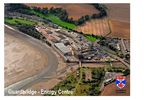University on its way to carbon neutral status
31st March 2014
The University of St Andrews is well on its way to achieving its strategic goal of becoming carbon neutral for its energy consumption. Alongside recently approved plans for a six-turbine 12MW wind power development at university land at Kenly 4 miles east of St Andrews, the University has commenced the planning process to establish a £25 million Renewable Energy Centre on the site of the former Curtis Fine Papers Mill at Guardbridge. St Andrew is a valued EAUC Member and a
UCCCfS participant.
The 6MW Energy Centre at Guardbridge is backed by a £10 million grant from the Scottish Funding Council which is supporting carbon reduction schemes across Scottish Higher Education, and the University proposes to generate power through clean biomass at Guardbridge and pump hot water 4 miles underground to St Andrews to heat and cool its labs and residences. The biomass facility will use only virgin roundwood, locally sourced from sustainable forests.
The green energy produced at Guardbridge and at Kenly will cut carbon, help the University protect jobs and ward off the effects of rising external energy prices. Although St Andrews University has managed to cut its power consumption in recent years, energy prices have been continually hiked by the large energy generators, representing a major threat to investment in front line teaching and research.
In addition to the Energy Centre at Guardbridge, the University also hopes to establish a Knowledge Exchange Hub to provide “missing link” facilities which would allow research and discoveries made in university labs across Scotland and the UK to be translated to working prototypes. The Centre will also offer affordable accommodation to local companies, with the aim of attracting businesses and skills linked to the renewables sector.
Subject to planning permission, the Guardbridge site will be renamed the Sustainable Power and Research Campus (SPARC), work will start onsite in 2014 with the Renewable Energy Centre complete and operational by December 2015.
These two major renewable energy projects reinforce the University’s already well-established energy and resource use reduction initiatives. These two macro-renewable projects will reduce carbon emissions by 25,000tonnes per annum. The University already successfully operates a £1.9M SALIX energy investment fund.
University Environment and Energy Manager said: “Our work on reducing our carbon footprint through the creation of our own energy in the form of heat and electricity is now coming to fruition and it is very satisfying to see these projects take shape. Delivering this vision at this scale has been a challenge but well worth it.”
Visit St Andrews' sustainability pages for more information on their programme.








 Except where otherwise stated, content on this site is
licensed under a Creative Commons Attribution 3.0 License.
Except where otherwise stated, content on this site is
licensed under a Creative Commons Attribution 3.0 License.
